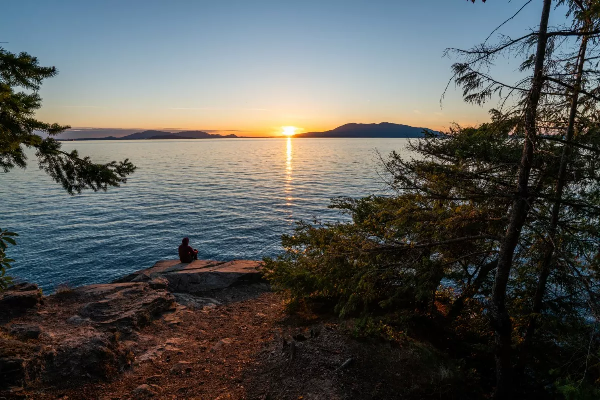Chuckanut Drive
April 20, 2022 at 8:33 a.m.

In the spring of 1916 Chuckanut Drive opens. Chuckanut Drive (State Route 11) is a bucolic 20-mile drive that begins at Exit 231 on Interstate 5 on the northern outskirts of Burlington (Skagit County). It travels northwest for nine miles along a pleasant but flat drive through the northern end of the Skagit Valley. When it reaches the edge of Samish Bay, the real scenery starts. With terrific views of Chuckanut Bay, the road continues its now-winding northwest trek through forest into Bellingham (Whatcom County), where it connects with the Old Fairhaven Parkway. Chuckanut is a Native term which in English means "long beach far from a narrow entrance."
To Build A Road
Chuckanut Drive had its beginnings in the mid-1890s as a rough logging road, but it was not the first road through the area. Since the 1860s there had been a road of sorts -- more like a trail in the Skagit County section -- between Fairhaven (now [2011] part of Bellingham) and Blanchard (about three miles northeast of Edison). In 1892 the Great Northern Railway bought the right of way to this road, and it was discontinued. The road, at least in Skagit County, had followed a route similar to today's Chuckanut Drive, although calling it a "road" is generous -- people traveling on it near the water were often blocked by high tide and had to wait until it dropped enough to let them pass.
In 1896 a logging road was built to replace the original road, but for its first 10 years, it really couldn't be called a road either. In 1905 the Washington State Legislature allocated funds for an improved road to run from Bellingham to Bow, but funding ran out after only a few miles were completed. At this point wealthy Bellingham resident Charles X. Larrabee (1843-1914) stepped in. Larrabee had a vision of a scenic drive running along Samish and Chuckanut bays, and, aided by his business partner Cyrus Gates (1858-1927), surveyed parts of the road. They also obtained funding to build the Fairhaven section of the road in 1907.
In 1909 the legislature appropriated $25,000 ($615,000 in 2011 dollars) for further improvements of what was then known as Waterfront Road. Construction was carried out during 1910 by convicts monitored by armed guards. But the convicts were not skilled at road construction, and the road was hard to build anyway; parts of the roadbed had to be blasted out of the cliffs overlooking the water. Still, the convicts completed more than five miles of roadway along its southern end in Skagit County.
In 1913 the legislature appropriated $53,000 ($1.2 million in 2011 dollars) for more roadwork. That same year, the not-quite-finished road was designated part of the Pacific Highway, a designation that remained until 1931. But there were problems with this final round of work, which was initially handled by a private company, Quigg Construction. This part of the road was directly above Great Northern Railway's track, and its construction caused frequent landslides that rained down on the rails below, causing big headaches for both state and railway officials. The state highway department eventually took over the completion of the road, and it opened in the spring of 1916. The total cost of construction was $135,000, or $2.8 million in 2011 dollars.
 View from Oyster Dome on Chuckanut Moutain
View from Oyster Dome on Chuckanut Moutain
Smuggling and Scenery
The drive gained instant popularity for its scenic views. In its original incarnation it was a narrow dirt and gravel road, but paving -- and widening -- of the road began in 1919. By 1921 most of the road had been paved, with the exception of a two-mile stretch between Oyster Creek and Blanchard, which was not paved until 1930. Improved concrete bridges replaced older wooden bridges at Oyster Creek in 1925 and Blanchard in 1930. The road’s concrete paving was replaced with asphalt in 1958, providing a smoother ride for motorists.
Chuckanut Drive proved an irresistible temptation to smugglers bringing both narcotics and liquor from Canada into the allegedly dry America of the Prohibition years of the 1920s. A 1922 Seattle Times article, describing a cocaine bust in Seattle, explained that the drug had been transported from Vancouver "along Chuckanut Drive, the liquor runners' road" ("Federal Agents Look For Narcotics Runners"). But this problem waned in 1931 when a bypass route for the Pacific Highway opened farther inland, and Chuckanut Drive became the scenic drive for which it was originally intended. The worst motorists have since had to worry about are the frequent washouts and mudslides that have always plagued the drive.
Larrabee State Park
 Larrabee, along Chuckanut Drive, is the state's first park
Larrabee, along Chuckanut Drive, is the state's first parkThis essay is courtesy of HistoryLink.org,the free online history of Washington State history
Sources: Paul Dorpat and Jean Sherrard, Washington Then And Now (Englewood, Colorado: Westcliffe Publishers, 2007), 13; Robert Thomas, Chuckanut Chronicles, (Bellingham: Chuckanut Fire District Auxiliary, 1971), 36-39; "Governor Accepts First Of Parks For State," The Seattle Times, October 24, 1915, p. 2; "New Road In North Finished," Ibid., May 28, 1916, Automobiles/Touring section, pp. 1, 3; "To Widen Scenic Drive," Ibid., April 1, 1919, p. 9; "Federal Agents Look For Narcotic Runners," Ibid., June 17, 1922, p. 3; "Park Name Changed," Ibid., February 18, 1923, p. 3; "Chuckanut Paving Will Start Soon," Ibid., February 2, 1930, p. 2; "Cyrus Gates," Find a Grave website accessed May 29, 2011 (http://www.findagrave.com); "The Inflation Calculator," website accessed May 14, 2011 (http://www.westegg.com/inflation/); "Washington Place Names Database," Tacoma Public Library website accessed May 30, 2011 (http://search.tacomapubliclibrary.org/wanames/browsewpn.asp); "Chuckanut Drive, State Route 11 Corridor Management Plan," Washington Department of Transportation website accessed May 28, 2011 (http://www.wsdot.wa.gov); "Larrabee," Washington State Parks website accessed May 30, 2011 (http://www.parks.wa.gov/parks/?selectedpark=Larrabee).





